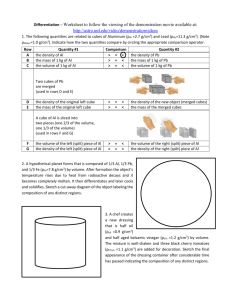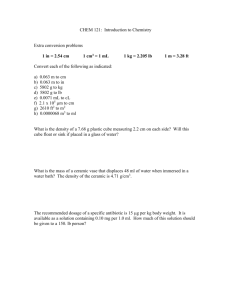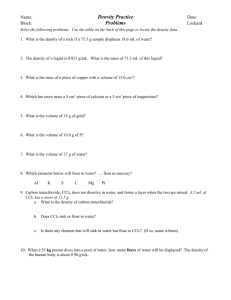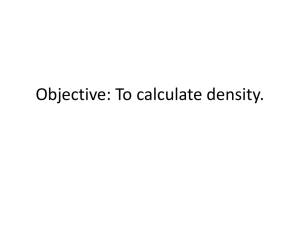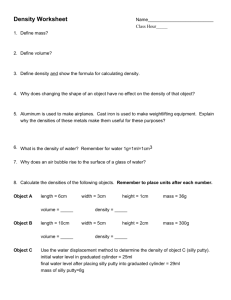Density Lab - SSA #2
advertisement
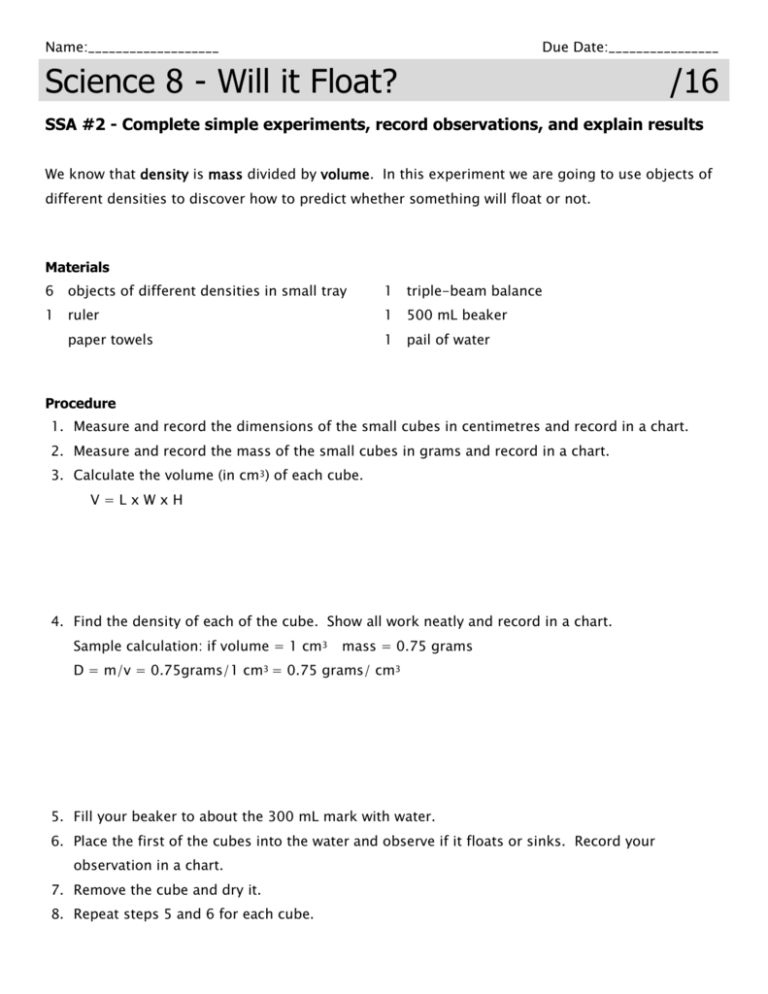
Name:___________________ Due Date:________________ Science 8 - Will it Float? /16 SSA #2 - Complete simple experiments, record observations, and explain results We know that density is mass divided by volume. In this experiment we are going to use objects of different densities to discover how to predict whether something will float or not. Materials 6 objects of different densities in small tray 1 triple-beam balance 1 ruler 1 500 mL beaker 1 pail of water paper towels Procedure 1. Measure and record the dimensions of the small cubes in centimetres and record in a chart. 2. Measure and record the mass of the small cubes in grams and record in a chart. 3. Calculate the volume (in cm3) of each cube. V=LxWxH 4. Find the density of each of the cube. Show all work neatly and record in a chart. Sample calculation: if volume = 1 cm3 mass = 0.75 grams D = m/v = 0.75grams/1 cm3 = 0.75 grams/ cm3 5. Fill your beaker to about the 300 mL mark with water. 6. Place the first of the cubes into the water and observe if it floats or sinks. Record your observation in a chart. 7. Remove the cube and dry it. 8. Repeat steps 5 and 6 for each cube. Observation table Cube Dimensions Mass Volume Density description Float or sink in water Discussion Questions (on separate sheet) 1. What can be said about the density of the floating objects? 2. What can be said about the density of the sinking objects? 3. The density of water is 1 g/cm3. Use your answers from 1 and 2 to complete the following sentence: An object will float on water if its density is __________________________ and will sink in water if _________________________________________. 4. Which of the cubes you tested would float on alcohol (density = 0.79 g/cm3)? 5. Which of the cubes would float in Mercury? (density = 13.6 g/cm3)? 6. Metals are more dense than water. Why do metal boats float? Science 8 SSA #2 Complete simple experiments, record observations, and explain results. Powerful/effective Capable/confident 4 3 All pre-lab activities are Most pre-lab activities complete and show an are complete and show excellent understanding of a good understanding of the experiment. the experiment. Partial/developing Limited/underdeveloped 2 0 Key pre-lab activities are Pre-lab activities incomplete complete and show at least and little or no evidence to an understanding of the main show understanding. objective of the experiment. All observations are recorded. Observations are understandable and accurate. All major observations recorded. Observations are understandable and accurate. All major observations Major observations missing. recorded. Most observations Some observations are hard are understandable and to understand or incorrect. accurate. Some small errors may be present. Explanation of Answers or discussion results. show an excellent understanding of the experiment. Answers or discussion show an understanding of the experiment. Some small errors. Report is correctly organised. N/A Answers or discussion show a basic understanding of the main points of the experiment. Some errors present. Report is complete. Small problems with organization. Criteria Prepare to carry out the lab. Recording observations. Report is complete and correctly organised. Total: /16 P/I Answers or discussion show very little or no understanding. Unfinished. Report is not complete and/or not organised correctly. Unfinished. Sc Wt X2 Tot

